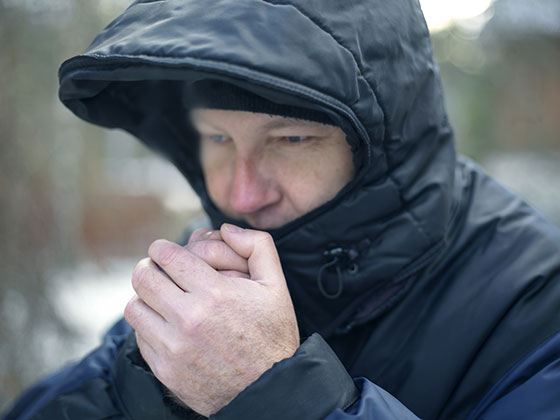With the arrival of winter, it is crucial to dress adequately. Extended exposure to the cold can lead to problems, including frostbite.
What is frostbite?
Canadian winters bring their share of enjoyment, but they are also characterised by a frigid cold. A number of outdoor activities are very popular with both young and old, but the biting cold can curb people's enthusiasm. When the choice is made to go ahead with one, it's important to use caution and dress warmly to avoid certain problems, such as frostbite.
Frostbite is an injury to an extremity caused by exposure to the cold, especially in the presence of humidity. It's location, extent, and severity may vary. The areas most often affected are the cheeks, nose, ears, chin, fingers, and toes. Young children are usually the most vulnerable to frostbite. However, anyone can fall victim to it.

How to recognize frostbite
Frostbite generally takes some time to develop, and the following factors can increase the risk of occurrence:
- dressing too lightly or with clothes that is humid or too tight
- being a woman
- poor blood circulation
- dehydration
- smoking and the consumption of alcohol or certain drugs
One of the first signs of frostbite is a loss of sensation. Then, skin weakened by the cold will become red and later turn white. The affected area will become stiff to the touch. People with frostbite will generally complain of a tingling sensation, numbness or pain. In some instances, no particular sensation is felt, especially when nerves are frozen. Loss of movement is also possible.
If the skin is exposed to the cold for an extended period of time, it becomes firm, white and waxy in appearance. The affected area can subsequently be more vulnerable to frostbite.
What are the complications associated with frostbite?
Here are some possible complications in the case of serious frostbite:
- blisters or ulcers that can ooze or bleed
- discolouration (greyish or blackened skin)
- skin infection
- etc.
It is important to mention that you should seek adequate medical care if needed.
How to prevent frostbite
Dressing adequately is often the key to success in enjoying winter without the unpleasantness of frostbite. A scarf, mitts, and warm boots are all important. Additionally, it is advisable to take several breaks inside to have snacks and hot beverages. Particular attention should be paid to very small children to prevent hypothermia and frostbite. Before each outdoor activity, it is preferable to check the temperature and wind chill factor.
At the first warning signs of frostbite, it is advisable to go indoors as quickly as possible to get warm. Why not take advantage of the opportunity to light a fire, drink a cup of hot chocolate or a delicious bowl of hot soup?

How to treat frostbite
Frostbite can sometimes develop into a serious injury. Certain actions can worsen the situation by causing small blood vessels to burst or damage skin further. To avoid this, make sure to:
- Never rub the affected area;
- Never apply products such as creams, ointments or other greasy substances;
- Never cover it with snow, cold water or hot water;
- Never use a heating object or fire source to warm it up.
Instead, here are the steps to take in case of frostbite:
- Move the person to a comfortable location inside.
- Gently remove clothes from the frostbitten area along with any other wet or tight-fitting clothes that could constrict blood flow.
- Remove rings and other jewellery if needed.
- Gradually warm the affected area with the hands or through contact with another warm area of the body (for example, by placing fingers under the armpits) without pressing too hard.
- Place the affected area in warm water.
- Gently move the affected joints to promote blood circulation.
- If the toes are affected, the person should avoid walking.
Once the limb has been warmed, the affected area may first feel numb, then swell and become hot, sensitive or painful. If pain occurs, it may be beneficial to take an analgesic. Always ask your pharmacist for advice before taking an over-the-counter medication.
When to consult a doctor
- If frostbite spreads or worsens.
- When the injury does not improve even despite following the above-mentioned measures.
- If bleeding, signs of infection or any other worrisome or unusual symptom occurs.
Don't hesitate to speak to your pharmacist if you have any question about frostbite or first aid.

